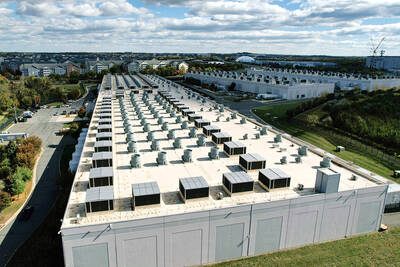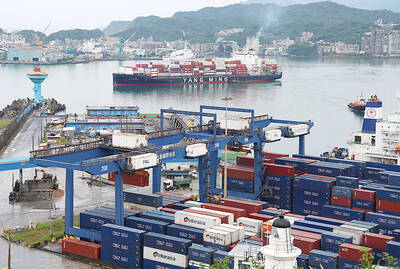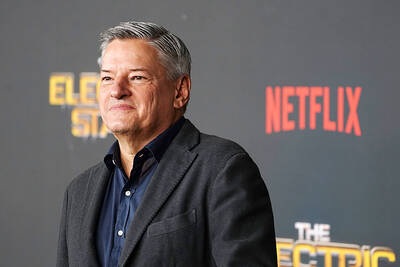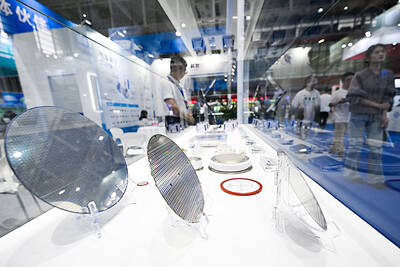European companies have been largely excluded from Chinese President Xi Jinping’s (習近平) Belt and Road Initiative (BRI) due to the dominant role of China’s state-owned enterprises and opaque bidding processes, a survey said, raising questions about the nation’s commitment to opening the program to the world.
A small number of European companies in China are involved in BRI, the EU Chamber of Commerce in China said in a survey of its members released yesterday in Beijing, with transparency topping the list of challenges European companies face.
A slightly larger number of European companies have seen positive knock-on effects through access to new logistics options and increased trade flows with countries hosting projects, it said.
“One of the most notable aspects about BRI-related projects is that they are rarely transparent,” the report said, adding that the businesses had come up against challenges to participation since the program’s inception.
Given the initiative’s scale, most respondents referred to their level of involvement as “crumbs from the table,” the report said.
Of 132 respondents to the chamber’s survey, just 20 indicated they had bid on at least one BRI-related project, with seven bidding as direct contractors and 13 as subcontractors.
Most of them participated after being pulled in by Chinese business partners or the government. All but a scant few have played niche roles, such as providing certain technology, it said.
More than half of respondents said there was insufficient information available to European companies seeking to make bids, and nearly 40 percent said that procurement systems for BRI-related projects were not transparent enough.
“China’s colossal national champions — boosted by state aid and cheap financing — are securing an unusually large proportion of contracts when compared to multilateral development schemes,” chamber president Joerg Wuttke said. “Europe needs to determine how to respond to this export of the China model to shield itself from market distortions and stay competitive in third-country markets.”
Chinese Ministry of Foreign Affairs spokesman Geng Shuang (耿爽) said that Chinese and foreign companies participating in the BRI followed market rules “based on the principle of fairness.”
“They participate in specific projects in an open and transparent way. The bidding process is transparent,” Geng told reporters in Beijing. “Whether companies participate or not is entirely companies’ own choice.”
The report comes as BRI has attempted to clean up its image after criticism that it is a debt trap for poor countries and allegations of corruption.
While it has advocated for the program to be more open, the chamber said it was not yet an inclusive, open global initiative.
Improving the quality of the projects is critical to “prevent ‘promise fatigue’ from once again becoming endemic in the international community,” it said.
The Chinese government clearly took note of some negative perceptions of the BRI during the initiative’s first half decade and “took corrective action,” the report said.
About a quarter of respondents indicated that the BRI was changing, trending toward improvement rather than worsening across various aspects of the initiative.
Italy became the first G7 nation to sign up for BRI in March last year.
As of June last year, China had established third-party market cooperation mechanisms with 14 developed countries, including France and Japan.
Third-party market cooperation — signing up a developed nation to help build infrastructure in Belt and Road countries — is the focus of the next phase of BRI to depoliticize the project and bring in more stakeholders, Bloomberg reported.
The BRI cooperation paper is chiefly a political declaration by two governments, Wuttke said.
In terms of business, “it has yet to produce any new opportunities for that country’s companies, and hasn’t driven the openness, transparency and accountability that we enjoy in multilateral finance schemes or schemes run by OECD [Organisation for Economic Co-operation and Development] member countries like Japan,” he said.

The demise of the coal industry left the US’ Appalachian region in tatters, with lost jobs, spoiled water and countless kilometers of abandoned underground mines. Now entrepreneurs are eyeing the rural region with ambitious visions to rebuild its economy by converting old mines into solar power systems and data centers that could help fuel the increasing power demands of the artificial intelligence (AI) boom. One such project is underway by a non-profit team calling itself Energy DELTA (Discovery, Education, Learning and Technology Accelerator) Lab, which is looking to develop energy sources on about 26,305 hectares of old coal land in

Taiwan’s exports soared 56 percent year-on-year to an all-time high of US$64.05 billion last month, propelled by surging global demand for artificial intelligence (AI), high-performance computing and cloud service infrastructure, the Ministry of Finance said yesterday. Department of Statistics Director-General Beatrice Tsai (蔡美娜) called the figure an unexpected upside surprise, citing a wave of technology orders from overseas customers alongside the usual year-end shopping season for technology products. Growth is likely to remain strong this month, she said, projecting a 40 percent to 45 percent expansion on an annual basis. The outperformance could prompt the Directorate-General of Budget, Accounting and

Netflix on Friday faced fierce criticism over its blockbuster deal to acquire Warner Bros Discovery. The streaming giant is already viewed as a pariah in some Hollywood circles, largely due to its reluctance to release content in theaters and its disruption of traditional industry practices. As Netflix emerged as the likely winning bidder for Warner Bros — the studio behind Casablanca, the Harry Potter movies and Friends — Hollywood’s elite launched an aggressive campaign against the acquisition. Titanic director James Cameron called the buyout a “disaster,” while a group of prominent producers are lobbying US Congress to oppose the deal,

Two Chinese chipmakers are attracting strong retail investor demand, buoyed by industry peer Moore Threads Technology Co’s (摩爾線程) stellar debut. The retail portion of MetaX Integrated Circuits (Shanghai) Co’s (上海沐曦) upcoming initial public offering (IPO) was 2,986 times oversubscribed on Friday, according to a filing. Meanwhile, Beijing Onmicro Electronics Co (北京昂瑞微), which makes radio frequency chips, was 2,899 times oversubscribed on Friday, its filing showed. The bids coincided with Moore Threads’ trading debut, which surged 425 percent on Friday after raising 8 billion yuan (US$1.13 billion) on bets that the company could emerge as a viable local competitor to Nvidia